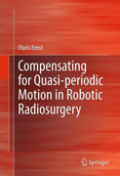
Compensating for Quasi-periodic Motion in Robotic Radiosurgery outlines the techniques needed to accurately track and compensate for respiratory and pulsatory motion during robotic radiosurgery. The algorithms presented within the book aid in the treatment of tumors that move during respiration. In Chapters 1 and 2, the book introduces the concept of stereotactic body radiation therapy, motion compensation strategies and the clinical state-of-the-art. In Chapters 3 through 5, the author describes and evaluates new methods for motion prediction, for correlating external motion to internal organ motion, and for the evaluation of these algorithms’ output based on an unprecedented amount of realclinical data. Finally, Chapter 6 provides a brief introduction into currently investigated, open questions and further fields of research. Compensating for Quasi-periodic Motion in Robotic Radiosurgery targets researchers working inthe related fields of surgical oncology, artificial intelligence, robotics and more. Advanced-level students will also find this book valuable. Describes in great detail the technology behind the advanced motion compensation algorithms used in radiotherapy. Explores cutting-edge, new algorithms for motion prediction and correlation. Surveys an unprecedented amount of clinical data, in order to emphasize the relevancy and necessity for new algorithms in radiosurgery. INDICE: Introduction. Motion Compensation in Robotic Radiosurgery. Signal Processing. On the outside: prediction of human respiratory and pulsatory motion. Going inside: correlation between external and internal respiratory motion. Conclusion. Appendix.
- ISBN: 978-1-4614-1911-2
- Editorial: Springer New York
- Encuadernacion: Cartoné
- Páginas: 241
- Fecha Publicación: 28/01/2012
- Nº Volúmenes: 1
- Idioma: Inglés
